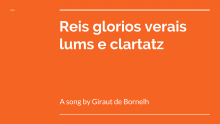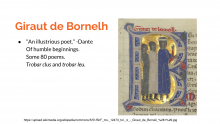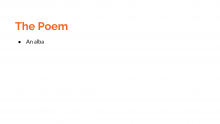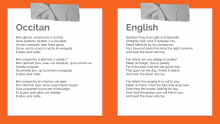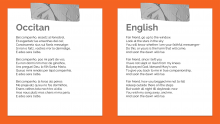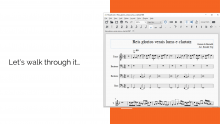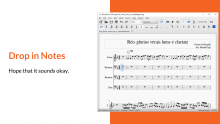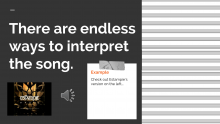Statement of Intent:
Experimentation and innovation are the way of the troubadours. In medieval times, their poems and melodies exemplified beautiful works that would impress listeners and inspire future artists. Troubadour music, though very innovative in its time, has endured years of the development of music in terms of theory and performance. In the present day, performance and interpretation of these songs with new methods has been questioned, and as a result, interpreters have had to defend their works.
Richard Taruskin posed a crucial question in 1995: When it comes to performing musical works, how do we balance historical authenticity and innovation? With Taruskin’s essay, “The Pastness of the Present and the Presence of the Past,” he answers many parts of this question, stating that performance in the presence is for our time and while appreciating the merit of the original works, authenticity originates in the retaining the spirit of the music and its performance.
A work by Margaret Switten, “Music and versification,” found in “Troubadours, an Introduction,” praises the works of the troubadours for their alluring vocabulary, structure, rhyme, and melody. She then makes similar meaningful inquiries about performance, analyzing the relationships between performer and audience, and potential effects this would have on the performance itself, as well as focusing on the central aspects of troubadour music: melody, rhetoric, and subtleties in versification.
This a cappella arrangement of Giraut de Bornelh’s “Reis glorios verais lums e clartatz” expands upon this discussion of modern interpretation of old music, while praising and adopting features of the original work by reviving it in a new art form. With no audio records of the troubadours themselves, it is impossible to know exactly how their music was performed. Occasionally, we have their lyrics and musical notations, which were retained for this arrangement, which builds on an existing melody and poem. This arrangement of “Reis glorios,” in the spirit of the troubadours, combines current techniques and art forms to express the message of the poem: the story of a loyal watchman, calling out to his friend. Dawn has come.
Notes on the arrangement itself:
The original melody of the stanzas is retained. The lyrics of the original work are also retained. Chords were selected in order to make the sound more full and to add direction. The arrangement fades from silence into simple dyads supporting the melody for the first stanza. In the second stanza, the chords are more defined by the additional baritone part that enters. Complexity grows, as in the third stanza, a harmony for the melody is sung by the top baritone part. In the fourth stanza, basses sing in unison with the melody to emphasize it, and in the fifth stanza, basses back off to their original role to allow a modified baritone harmony to sing with the melody. In the sixth stanza, the simplicity of the second stanza returns for the song to close.
Works Cited
Goldin, Frederick. Lyrics of the Troubadours and Trouvères: An Anthology and a History. New-York: Anchor, 1973. Print.
Switten, Margaret. "Music and Versification." An Introduction The Troubadours (n.d.): 141-63. Web.
Taruskin, Richard. Essays on Music and Performance. New York: Oxford UP, 1995. Print.
Arrangement starts here:

